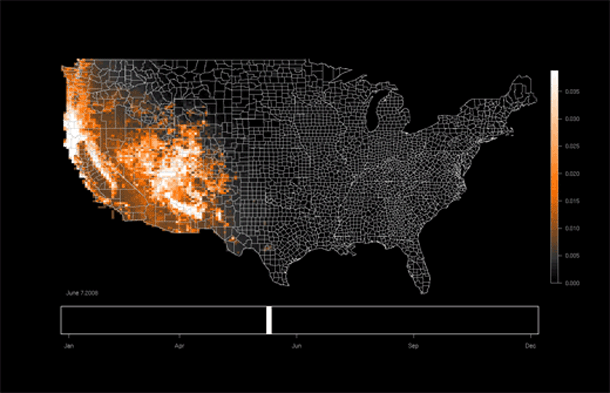A large part of the work on animal architecture is understanding, mapping and visualizing patterns of movement in ourselves and our non-human clients or design-partners. Over the years we have encountered several resources for visualizing animal movement and a few of our favorite (and most useful) ones are listed below.
Aerial Photography
The beginner’s first step is a basic image search for aerial photography. This can be quick, easy and indicative of the amount of images on the web for a given species. Some of our favorite and, most useful images are below.
EBIRD
eBird documents the presence or absence of species, as well as bird abundance through checklist data. A simple and intuitive web-interface engages tens of thousands of participants to submit their observations or view results via interactive queries into the eBird database. eBird encourages users to participate by providing Internet tools that maintain their personal bird records and enable them to visualize data with interactive maps, graphs, and bar charts. All these features are available in English, Spanish, and French.
A birder simply enters when, where, and how they went birding, then fills out a checklist of all the birds seen and heard during the outing. eBird provides various options for data gathering including point counts, transects, and area searches. Automated data quality filters developed by regional bird experts review all submissions before they enter the database. Local experts review unusual records that are flagged by the filters.
Screengrabs from the eBird Website. Top: National Hotspot map for bird watching enthusiasts. Bottom: Heat-map for yearly migratory pattern of the Black-throated Gray Warbler
MOVEBANK
Screenshot of the movebank search interface showing migration patterns of swallows over Eastern Africa.
Movebank is a free, online database of animal tracking data hosted by the Max Planck Institute for Ornithology. We help animal tracking researchers to manage, share, protect, analyze, and archive their data. Movebank is an international project with over three thousand users, including people from research and conservation groups around the world.
How does Movebank work? The animal tracking data accessible through Movebank belongs to researchers all over the world. Researchers can choose to make part or all of their study information and animal tracks visible to other registered users, or to the public.
What is animal tracking? Animal tracking data helps us understand how individuals and populations move within local areas, migrate across oceans and continents, and evolve through millennia. This information is being used to address environmental challenges such as climate and land use change, biodiversity loss, invasive species, and the spread of infectious diseases. Read more
Dennis Hlynsky’s Animal Tracks
Starlings at Sunset from Dennis Hlynsky on Vimeo.
Water Striders from Dennis Hlynsky on Vimeo.
A special thanks to Chris Valdez for sending in the Dennis Hlynsky link.
Consult Animal Architecture
And always there are projects already on Animal Architecture explicitly focused on visualizing and presenting animal paths. The insect art of Edhv and the Plant growth Mapping art installation of David Bowen being among the two most directly related projects.
















